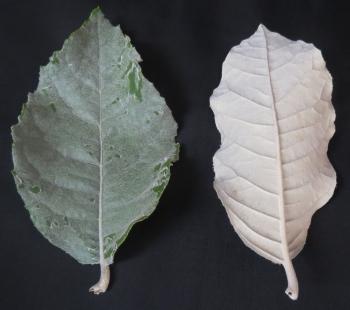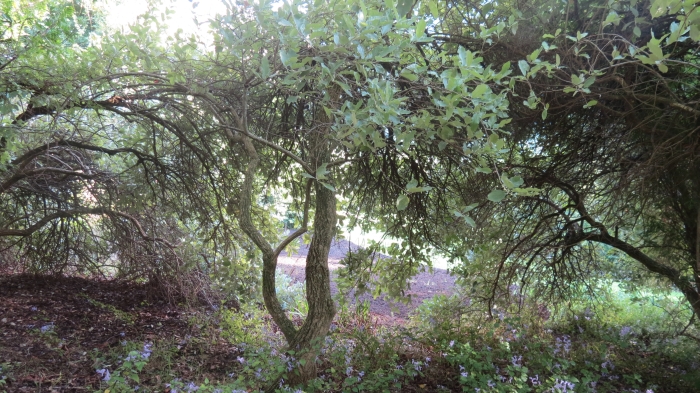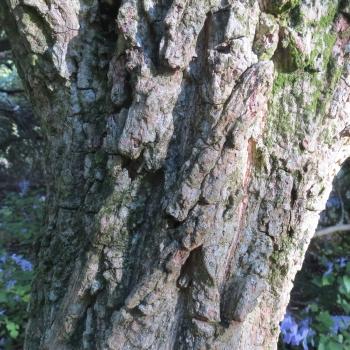Brachylaena rotundata
Brachylaena rotundata S.Moore
Family: Asteraceae
Common names: mountain silver-oak, Transvaal silver-tree (Eng.); bergvaalbos, bergvaalboom (Afr.); moswane (Tsw)
SA Tree No: 730
Introduction
This tree is ideal for small to medium-sized gardens. It produces yellow, thistle-like flowers in spring and has eye-catching, silver-grey leaves, that boast with reddish tinges in autumn.

Description
Description
This small, deciduous tree or shrub, with its drooping branches, reach a height of 3–5 m in the domestic garden, but may grow as high as 8 m in its natural environment. White hairs cover the young branches, but loses the hairs as it becomes more mature and lenticels (small openings in the bark) appear. The alternately arranged, elliptical leaves are ± 40–100 × 25–60 mm, leathery green on the top surface, losing hairs on its surface as it matures, however, the hairs on the undersurface of the leaves, which are usually grey or white, is quite significant and gives a silver-grey appearance to the leaf.

Flower heads appear in clusters in terminal panicles and are about 40–400 mm long; they may also appear in short raceme-like panicles, in the axils of leaves. The involucre (a number of bracts surrounding the base of a flower head) is cup-shaped; the bracts appear in rows of 5–8 and decreasing in size and extending down to the base of the capitulum (type of inflorescence in which the flowers are collected in a dense head) stalk. The flowers are dioecious, with male and female flowers occurring on separate trees. Heads with female flowers are larger and produce larger pappi (rings of hairs round the top of the ovary). The flower heads are often produced before the leaves.

The fruit takes the form of a small nutlet, with an apical tuft of tawny bristles, which is about 5 mm long.

Conservation Status
Status
According to the Red List of South African plants, checked on the 2018/03/07, the conservation status of this tree is Least Concern (LC).
Distribution and habitat
Distribution description
Brachylaena rotundata is not endemic to South Africa; it also occurs in eastern Botswana, Mozambique, Zambia and Zimbabwe. The tree’s provincial distribution covers Free State, Gauteng, Limpopo, Mpumalanga and North West. It grows in open woodland, on rocky koppies and slopes, on stream banks and occasionally on termite mounds.

Derivation of name and historical aspects
History
The name Brachylaena is derived from the Greek word brachus, which means ‘short’ and chlaina, which means ‘cloak’ and refers to the florets which are longer than the bracts surrounding the flower head, and rotundata is a Latin word which refers to the partly rounded apex and irregularly toothed leaves.
The genus Brachylaena includes flowering trees and shrubs and belongs in the Asteraceae family. Nine of the ±15 species that are found in Africa and the Mascarene Islands, appear in southern Africa.
Ecology
Ecology
The flowers attract bees by producing significant amounts of nectar. The mature leaves are quite bitter, but the younger leaves are often observed eaten by game.

Uses
Use
This species produces dense, strong timber, but not of any useful size or straightness, compared to the wood of species such as B. discolor, which lasts well in water and is often used in the building of small boats. The branches of this tree were often used in the construction of huts, especially the roof. People used to make knobkerries and axles from the wood as well.
Growing Brachylaena rotundata
Grow
This tree is very hardy, wind resistant and does not need a lot of water. Young trees establish well after the first 2 years. The root system is not aggressive and the tree can be used as an excellent screening plant to keep unwanted visitors out. The tree grows well in soil with a good drainage and added compost, will excel its growth.
Sow the seeds in seedling trays in summer in a well-drained medium, such as river sand.
It is important to keep the soil moist and place the trays in a sunny position. To prevent pre-or post-emergence damping off, a fungicide can be applied to the seeds. This will increase the success rate of germination. The germination of the seed is very erratic but will appear after about a month. The best time to transplant the seedlings into bags, is when they reach the 2-leaf stage. Wait at least a year before planting them out into the open ground.
Take hardwood cuttings in early spring; make the cuttings about a 100–150 mm long and about the diameter of a pencil. Apply a root hormone powder to the cuttings and use river sand as a growth medium. The young plants grow relatively fast and are easy to transplant.
References
- Boon, R. 2010. Pooley's trees of eastern South Africa, a complete guide. Flora & Fauna Publications Trust, Durban.
- Coates Palgrave, K. 2002. Trees of southern Africa. Struik, Cape Town.
- Esterhuyse, N., Von Breitenbach, J. & Söhnge, H. 2001. Remarkable trees of South Africa. Briza Publications, Pretoria.
- Harris, G. & Harris, M.W. 1994. Plant identification terminology, an illustrated glossary. Spring Lake, Utah.
- Van Wyk, B. & Van Wyk, P. 1997. Field guide to trees of southern Africa. Struik, Cape Town.
- Venter, F. & Venter, J.A. 2012. Making the most of indigenous trees. Briza Publications, Pretoria.
- Von Breitenbach, F. 1990. National list of indigenous trees. Second revised edition. Dendrological Foundation, Pretoria.
- Coates Palgrave, K.P. & M. 1985. Everyone's guide to trees of South Africa. Struik, Cape Town.
- Foden, W. & Potter, L. 2005. Brachylaena rotundata S.Moore. National Assessment: Red List of South African Plants version 2017.1. Accessed on 2018/03/07
Credits
Benjamin Festus
Kirstenbosch National Botanical Garden
May 2018
Plant Attributes:
Plant Type: Tree
SA Distribution: Free State, Gauteng, Limpopo, Mpumalanga, North West
Soil type: Sandy, Loam
Flowering season: Spring
PH: Acid, Neutral
Flower colour: Cream, Yellow
Aspect: Full Sun
Gardening skill: Average
Special Features:
Horticultural zones











Rate this article
Article well written and informative
Rate this plant
Is this an interesting plant?
Login to add your Comment
Back to topNot registered yet? Click here to register.